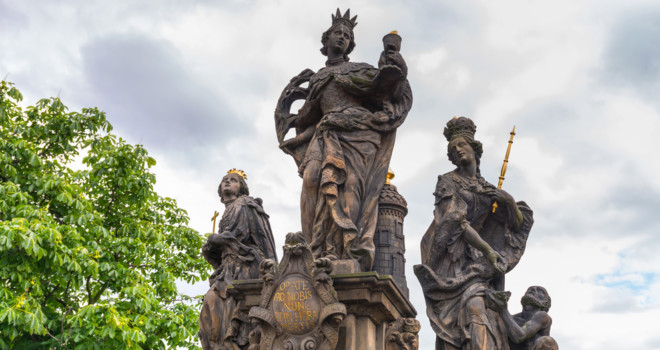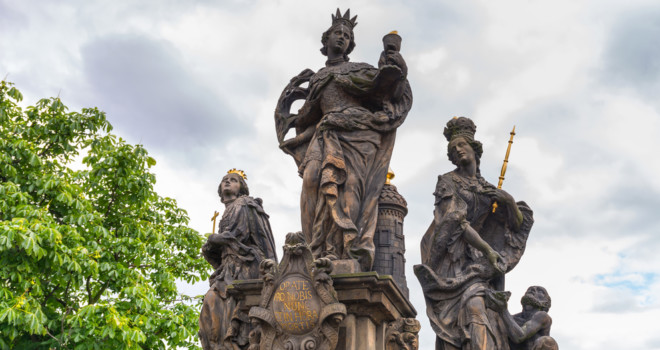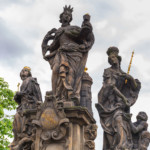St. Barbara
The feast of St. Barbara on December 4 may seem to have no apparent connection with Advent other than the date; but it does connect, as you will see. She is especially important to our children, and they consider it “de rigueur” to salute her on her feast day since she is the patroness of those who call for protection against lightning and electrical storms.
She was the daughter of a pagan who placed her in a tower surrounded by marvelous gardens, and sent philosophers, poets, and scholars to teach her all things. Convinced that polytheism was nonsense, she consulted Origen, one of the most brilliant and controversial of early Christian apologists; he sent her his disciple Valentinium, who forthwith instructed and baptized her. She thereupon threw all the statues of pagan gods and goddesses out a window of her tower, traced the Sign of the Cross everywhere on the walls, and had a third slit of a window cut in honor of the Holy Trinity.
This upset her father no end. He had her dragged out of the tower, but she somehow escaped to the mountains as he was about to slay her. He pursued her and dragged her back by the hair of her head (which is why she is sometimes pictured being dragged about by the hair) and handed her over. She was beaten with rods, torn with iron hooks, and suffered other horrible torments.
The best part of the story is that, as she was being carried to Heaven by the angels, her father is supposed to have been struck dead by lightning and “hurried before the judgment seat of God.” Hence her concern that we be preserved from lightning and from a sudden and unprovided death. She is also patroness of firemen, mathematicians, firework makers, artillery men, architects, smelters, saltpeter workers, brewers, armorers, hatters, tilers, masons, miners, and carpenters, and she is invoked against final impenitence.
With this to her credit, she is precisely the saint we want supporting us in our brave resolves at the start of Advent. So, on December 4, we sing at the dinner table, “Happy feast day, St. Barbara,” and tell her story. At night prayers, we invoke her help in the words of the Collect of her Mass:
O God, who, among the marvels of Thy power,
has given the victory of martyrdom even to the
weaker sex, grant in Thy mercy that we who keep
the birthday of blessed Barbara, Thy virgin and martyr,
may, by her example, draw nearer to Thee.
Through Our Lord Jesus Christ, Thy Son, who
liveth and reigneth with Thee in the unity of
the Holy Spirit, God, world without end. Amen.

St. Nicholas versus Santa Claus
On
December 6 comes the feast of the Christmas saint, St. Nicholas, although most
of our celebration of this feast comes on his vigil, December 5. We find a
puppet show a delightful way to tell his story, explain his relation to the
Christ Child, and introduce the hanging of stockings for his feast day.
St. Nicholas was really a Turk born in Asia Minor. For a
long time he was Bishop of Myra (near the southern coast of Turkey to the right
of the Island of Rhodes — in case you look for it on a map). An orphan, he grew
in love of God, became a priest, and made a pilgrimage to the Holy Land to
venerate the places of our Lord’s life. On the voyage, a terrible storm
threatened to sink the ship, but by his prayers all were saved. For this reason
he is venerated as patron of boatmen, fishermen, dock workmen, and sailors.
Returning
to his native land, he was made a bishop; his generosity and love for the poor
and for children, as well as his many miracles, endeared him to Christian
people all over the world. He is also venerated as the patron of scholars,
coopers and brewers, travelers and pilgrims, those who have unjustly lost a
lawsuit, and as patron and annual benefactor of schoolchildren (especially
boys), and is invoked against robbers and (in Holland) for protection of
seafaring men.
The story we like best is the well-known tale of the three marriageable daughters who were nevertheless unmarriageable for want of dowries. Hearing of their plight, the saint went silently by their house one night and tossed a bag of gold through the window for the oldest, who not long after found a husband for herself with no trouble at all. Then he crept by a second time and tossed a bag of gold through the window for the second daughter, who likewise was suddenly at no loss for suitors. As he was about to toss the gold through the window for the third daughter, the father of the girls caught sight of him. Throwing himself at his feet, he thanked him, confessed his sins, begged his blessing. Plainly it is from this story that the tradition has grown wherein St. Nicholas is said to leave gifts, candies, and sweets on windowsills, in shoes, and even in the stockings of good little children.
“Telling the truth about Santa Claus” need not rob
children of their Christmas magic. It adds to it with another feast to
celebrate, another saint to know and love, another emphasis gently persuading
them to meditate on the coming of the divine Child. And if we really fear to
take away that part of it which is surprise, that marvelous moment Christmas
morning when the presents are at last mysteriously there, be assured the little
ones continue to pretend. Our littlest ones, knowing the truth, continue to
pretend that it is all assembled in the most mysterious and magical fashion.
Santa Claus is not a serious lie, but St. Nicholas in his rightful place, gazing with us at the Christ Child, is a much lovelier truth.
St. Lucy and Christmas Wheat
The feast of St. Lucy, December 13, is a favorite among many peoples. St. Lucy’s story is another of the hair-raising tales of martyrdom ending in heavenly triumph, and we make the telling of it the focal point of our feast.
Lucy comes from the Latin word lux, which means “light,” and since we are preparing for the coming of the Light of the World, it is appropriate that her feast falls in Advent.
St. Lucy was born in Sicily. Since her mother was ill four years with a hemorrhage, Lucy reminded her that a woman in the Gospels with the same complaint was cured by our Lord, and suggested that perhaps praying at the tomb of St. Agatha, who died for love of Him, would procure her mother’s recovery. They went to the tomb and prayed all night until they fell asleep. St. Agatha appeared to Lucy in a vision, called her “sister,” and foretold her martyrdom. Her mother was instantly cured, and as a thanksgiving she gave away most of her money and goods to the poor. She then permitted Lucy to give away all her money and goods to the poor, as well as take a vow of virginity.
Refusing to marry her suitor because she had given herself to Christ, she was denounced by him as a Christian, tried in the praetorium and convicted, then sentenced to be despoiled in a house of ill-fame. But when they tried to drag her off, she would not budge. Raging, her persecutors poured pitch, oil, and resin over her and ignited it, only to see her stand amid the flames as cool as a cucumber.
“How
is it you do not burn?” they screamed. She replied that it was by the power of
her Lord Jesus Christ that she was saved, in order that she might be a witness
to Him. With that they plunged a dagger into her throat, and she finally died
and went straight to Heaven.
A legend that has grown up around St. Lucy has to do with her gouging out her eyes in order to destroy their beauty, which had attracted so many admirers. This explains a statue we saw not long ago showing Lucy, sweet-faced and crowned, offering us her eyes on a silver platter.
She is invoked for assistance with diseases of the eyes, with dysentery, and with hemorrhages; she is the patron saint of Sicily, especially the city of Syracuse, and apparently the Swedish people fell in love with her when her plucky story was carried north by the early Christian missionaries, and she became their patron saint of schoolgirls. Among the invocations to include in night prayers on her feast is: “Please, dear St. Lucy, help us to love purity.”
A beautiful Hungarian custom on the feast of St. Lucy is to plant the “Christmas wheat.” Pressed gently into a pot of garden soil, watered, and kept in a moderately warm room, the wheat will be sprouted soft green by Christmas. Then the children may carry it to the crèche as a gift for the Child Jesus, symbolic of the Eucharistic bread by which He feeds our souls at the altar, as well as of the staff of life by which His Father keeps life in our bodies.
✠
This article is from Mary Reed Newlands classic book, The Year and Our Children: Catholic Family Celebrations For Every Season. It is available through your favorite bookstore or online through Sophia Institute Press.













